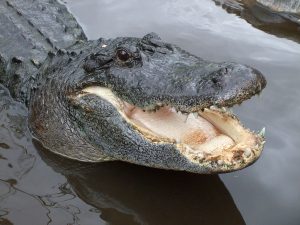This post was contributed by Dr Simon Pooley, Lambert Lecturer in Environment (Applied Herpetology) in the Department of Geography, Environment and Development Studies
 As portrayed in numerous films, including Disney classics like The Rescuers, the American alligator (Alligator Mississippiensis) is an iconic and well known denizen of the State of Florida. It is surely difficult to visit the Sunshine State without being aware of the presence of alligators, which are effectively managed by the Florida Fish and Wildlife Service. However, yesterday’s attack on a two-year old visitor to Disney’s Grand Floridian Resort & Spa in Orlando, Florida, is a sad reminder that coexisting with large and potentially dangerous predators brings risks and responsibilities.
As portrayed in numerous films, including Disney classics like The Rescuers, the American alligator (Alligator Mississippiensis) is an iconic and well known denizen of the State of Florida. It is surely difficult to visit the Sunshine State without being aware of the presence of alligators, which are effectively managed by the Florida Fish and Wildlife Service. However, yesterday’s attack on a two-year old visitor to Disney’s Grand Floridian Resort & Spa in Orlando, Florida, is a sad reminder that coexisting with large and potentially dangerous predators brings risks and responsibilities.
For those visiting Florida’s manicured gardens and golf courses and its theme parks and holiday resorts, it might seem that alligators are denizens of ‘the wild,’ of remote and inaccessible swamps and creeks. As this terrible incident reminds us, in fact alligators are widespread throughout natural and manmade waterways in the State, and it should never be assumed that alligators are not present unless explicit information is available to the contrary. This was highlighted in a widely reported incident just two weeks ago when a very large alligator strolled across a golf course in Palmetto, Florida.
While this attack may be ‘very rare’ (to quote Nick Wiley, executive director of the Florida Fish and Wildlife Conservation Commission), there have been at least 2-4 alligator bites per year reported in the state since record-keeping began in the early 1970s (deaths are much rarer). Being bitten by an alligator is thus always a possibility, though the risk is very small compared to the many other accidents that could occur. Witnesses interviewed after the attack lamented the lack of signs warning of the dangers of alligators, but it is a stretch to expect authorities to signpost every body of water in the State where alligators could turn up. Certainly areas home to stable populations of large alligators and accessible to people should be signposted. In fact, Florida has been a pioneer in the management of human-alligator incidents.
Following federal and state regulations in the 1970s, alligators were effectively protected and swiftly recovered, and complaints about ‘nuisance alligators’ rocketed. A Statewide Nuisance Alligator Program (SNAP) was put in place by the end of the decade, and today alligators are managed through a combination of targeted annual harvests, and incident response programmes outsourced to licensed hunters. Considering that the nearly 20 million inhabitants of the state, along with over 90 million visitors to the State annually, have a good chance of coming across the estimated 1.3 million alligators spread across all of its 67 counties, it is almost miraculous that so few incidents occur.
This incident is still unfolding, and more detail will emerge which may inform our understanding of the particular situation, but at this stage it seems that the incident should be viewed as a terrible accident. There are good educational materials available through the Florida Fish and Wildlife Commission website and public warnings should be issued in the months of peak alligator activity (April to August).
If we want large predators to exist outside of zoos and protected areas, which is necessary for their long-term survival, then we need to educate ourselves about their behaviour and how to behave around such animals. As wolves, bears, mountain lions, alligators and other large predators recover from past persecution and begin to range outside of fenced protected areas, we should learn about how to coexist with them, in the same way that we learn to behave safely around motor vehicles, roads, and also domesticated animals (which are responsible for more deaths and injuries than wild animals). We also need well trained and resourced wildlife management officials to respond swiftly and effectively when tragedies occur.
